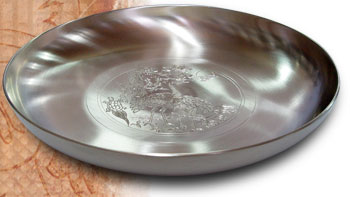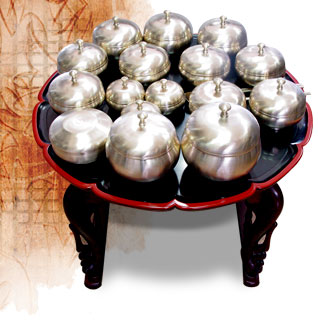| Napcheong, Yi’s hometown, was once a prosperous center of the Korean bronzeware and bronze gifts industry, support for his early mastery of the skills. Expertise evolved rapidly, and customers appeared. At last, he mastered all the techniques required to become a top bangjja artisan, and opened his own workshop, 10 years after he entered the industry as a means to flee from poverty. Unfortunately, Korea was immersed in an age when traditional bronzeware utensils used for religious services, wedding gifts and kitchen items of daily use were being quickly replaced by cheap, mass-produced articles of stainless steel and plastic. He strived to keep his workshop, but by the 1970s it was clear to him that no customers would visit his workshop, or anyone's bronzeware shop. However, he experienced a breakthrough when he found that traditional musical instruments such as the gong could only make the proper sound when it is made through traditional bangjja methods. Traditional bronze percussion requires the proper thickness and size, which only can be achieved by hammering, in order to create finely tuned sounds. Yi Bong-ju proved his worth in this new area, too, and satisfied his customers, most of whom were musicians, with a fine instrument that makes deep, long reverberations, which are the unique traits of Korean brass percussion instruments, appealing to the entire spectrum of human emotions. His achievement in preserving and developing the traditional bangjja art despite extreme poverty and difficult ordeals was officially recognized in 1983 when the Korean government designated him as a Yugijang ('Master Craftsman of Bronzeware'), and bestowed upon him the honorary title of 'Important Intangible Cultural Property.' Afterwards Yi began to focus on incorporating traditional bangjja art into modern lives, believing that even the best bangjja ware is nothing but a stale museum piece unless it is used by people every day. He created an elegant golden hue with reduced tones for his ware to replace the traditional glossy gold, as well as introduced new sizes suitable for modern usage and new designs, including one inspired by a floral Goryeo celadon dish. His efforts helped change people’s attitudes towards bangjja and increased demands for bronzeware. Currently, his bangjja utensils are regarded as some of the best tablewares, and are regularly used for the Korean president's dining table as well as official state dinners for international dignitaries. Yugijang Yi Bong-ju is currently carrying out a huge lifetime project. He has recently purchased a piece of land of 40,000 pyeong (approximately 7,200 square meters) in the town of Mungyeong, Gyeongsangbuk province, to establish a new View the master's works |
|||||||||||
|


















